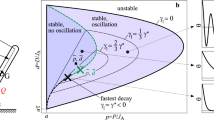Abstract
Postural perturbations are often used in experimental investigations of human balance and postural control. Treating the perturbation as the input and the resulting postural sway response as the output, an input/output model of the posture-control system can be identified. Selection of the perturbation parameters can have a substantial influence on the accuracy of the identification and on the interpretation of the results. Pertinent parameters include type of perturbation, waveform, power spectrum, bandwidth, amplitude and test duration. The selection of these parameters is discussed in the light of general requirements for persistent excitation, accurate identification, stationarity and subject safety. Experimental results are used to illustrate specific issues.
Similar content being viewed by others
References
Allum, J. H. H. andBudingen, H. J. (1979) Coupled stretch reflexes in ankle muscles: an evaluation of the contributions of active muscle mechanisms to human posture stability.Progr. Brain Res.,50, 185–195.
Anderson, J. H., Soechting, J. F. andTerzuolo, C. (1977) Dynamic relations between natural vestibular inputs and activity of forelimb extensor muscles in the decerebrate cat. 1. Motor output during sinusoidal linear accelerations.Brain Res.,120, 1–15.
Andres, R. O. andAnderson, D. J. (1980) Designing a better postural measurement system.Am. J. Otol.,1, 197–206.
Andres, R. O. (1982) Diagnostic implications of induced body sway. InNystagmus and vertigo,Towe,A. L. andLushei,E. S. (Eds.), Academic Press, New York, 191–204.
Bendat, J. S. andPiersol, A. G. (1971)Random data: analysis and measurement procedures. Wiley-Interscience, New York.
Box, G. E. P. andJenkins, G. M. (1976)Time series analysis: forecasting and control. Holden-Day, San Francisco.
Diener, H. C., Dichgans, J., Bootz, F. andBacher, M. (1984) Early stabilization of human posture after a sudden disturbance: influence of rate and amplitude of displacement.Exp. Brain Res.,56, 126–134.
Doebelin, E. O. (1980)System modelling and response: theoretical and experimental approaches. John Wiley & Sons, New York.
Eykhoff, P. (1974)System identification: parameter and state estimation. John Wiley & Sons, London.
Gantchev, G., Dunvev, S. andDraganova, N. (1972) On the problem of the induced oscillations of the body.Agressologie,13B, 51–55.
Gantchev, G. andPopov, V. (1973) Quantitative evaluation of induced body oscillations in man.,14C, 91–93.
Goodwin, G. C. andPayne, R. L. (1977)Dynamic system identification. Academic Press, New York.
Graupe, D. (1976)Identification of systems. Van Nostrand Reinhold, New York.
Gurfinkel, V. S., Lipshits, M. I., Mori, S. andPopov, K. Y. (1976) The state of stretch reflex during quiet standing in man.Progr. Brain Res.,44, 473–486.
Hibino, R. (1980) The role of tonic stretch reflex during standing in man.Nagoya J. Med. Sci.,43, 15–24.
Honjo, S. andFurukawa, R. (1957) The goniometer test.Ann. Otol. Rhinol. Laryngol.,66, 440–458.
Isermann, R. (1980) Practical aspects of process identification.Automatica,16, 575–587.
Ishida, A. andImai, S. (1980) Responses of the posture-control system to pseudorandom acceleration disturbances.Med. & Biol. Eng. & Comput.,18, 433–438.
Litvintsev, A. I. (1973) Mechanisms of man's vertical posture control.Agressologie,14B, 17–21.
Maki, B. E. (1986) Interpretation of the coherence function when using pseudorandom inputs to identify non-linear systems.IEEE Trans.,BME-33 (in press).
McCormick, E. J. (1976)Human factors in engineering and design. McGraw-Hill, New York.
Meyer, M. andBlum, E. (1978) Quantitative analysis of postural reactions to induced body oscillations.Agressologie,19A, 30–31.
Nashner, L. M. (1971) A model describing vestibular detection of body sway motion.Acta Otolaryng.,72, 429–436.
Nashner, L. M. (1976) Adapting reflexes controlling the human posture.Exp. Brain Res.,26, 59–72.
Nashner, L. M. (1977) Fixed patterns of rapid postural responses among leg muscles during stance.,30, 13–24.
Nashner, L. M., Woollacott, M. andTuma, G. (1979) Organization of rapid responses to postural and locomotor-like perturbations of standing man.,36, 463–476.
Nashner, L. M. (1980) Balance adjustments of humans perturbed while walking.J. Neurophysiol.,44, 650–664.
Nashner, L. M. andCordo, P. J. (1981) Relation of automatic postural responses and reaction-time voluntary movements of human leg muscles.Exp. Brain Res.,43, 395–405.
Rake, H. (1980) Step response and frequency response methods.Automatica,16, 519–526.
Stark, L. (1968)Neurological control systems. Plenum Press, New York.
Terekhov, Y. (1976) Stabilometry and some aspects of its applications: a review.Biomed. Eng.,11, 12–15.
Tokita, T., Miyate, H. andFujiwara, H. (1984) Postural response induced by horizontal sway of a platform.Acta Otolaryngol. Suppl.,406, 120–124.
Walsh, E. G. (1973) Standing man, slow rhythmic tilting, importance of vision.Agressologie,14C, 79–85.
Author information
Authors and Affiliations
Rights and permissions
About this article
Cite this article
Maki, B.E. Selection of perturbation parameters for identification of the posture-control system. Med. Biol. Eng. Comput. 24, 561–568 (1986). https://doi.org/10.1007/BF02446257
Received:
Accepted:
Issue Date:
DOI: https://doi.org/10.1007/BF02446257




